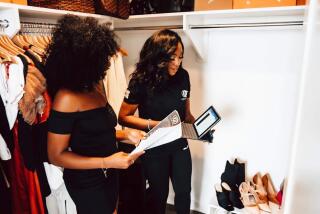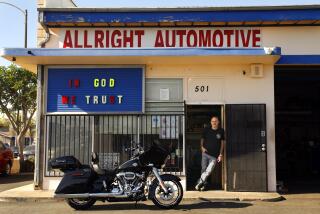Growth of toy-truck hobby shop is thrown off track
- Share via
Bashing pint-size radio-controlled monster trucks around bumpy dirt tracks has always been a blast for Dan Dunst, who opened a hobby shop specializing in the pricey toys near downtown Los Angeles last year.
But his store, VG Racing, was soon broadsided by the sour economy. Sales at the shop and its online sites have slipped over the last six months, and now Dunst and his wife, Sarah, have to figure out whether the company can continue.
“I’m being run over,” said Dunst, 50, who also designs and manufacturers custom roll cages for the zippy vehicles that sell for $250 to $800 or more.
Before he opened the shop, Dunst started an EBay business that last year sold $246,000 worth of radio-controlled cars and trucks, as well as spare parts and roll cages for the model vehicles.
He plowed $80,000 of his EBay profit into the store, investing heavily in parts and other inventory without making a clear business plan or budget.
But both the online sales and the start-up hobby shop have suffered in the poor economy, and Dunst is at that most difficult of decision points: whether to shut down all or part of his business.
Before he makes any decisions, Dunst needs to stop and count the costs, says Laura Yamanaka, president and co-founder of TeamCFO Inc., which provides outsourced financial executives and consulting services for small and medium-size businesses.
“Finance and accounting are like the bones in your body. They hold up your operation,” Yamanaka said.
He also needs to consider whether his location -- in the site of a former cabinet factory founded by his father and a partner -- is the best for retail. But before he starts worrying about that, Yamanaka said, Dunst has to make sure he has a viable business.
Yamanaka’s view is that Dunst’s best bet might be to refocus his efforts on the business he started with -- making roll cages for the radio-controlled cars and selling them on EBay.
But she said it’s impossible to know what the right course is until he really takes the time to analyze the businesses’ underlying financials.
Like many entrepreneurs, Dunst has avoided dealing with the numbers in a consistent, formal way. Without that information, especially in a bad economy, he risks making decisions that will steer his business further into a hole.
The first thing Dunst needs to do is stop or minimize the bleeding of cash, Yamanaka said. To do that, he needs to figure out exactly how much he has on hand. In the past, Dunst has relied on his bank account balance alone, but that doesn’t include outstanding purchases or payments about to land.
Next, he should tally the bare minimum needed to operate on a daily, weekly or monthly basis. This doesn’t include big investments such as inventory for the upcoming holidays, Yamanaka said. Dunst should pull out his stack of bills and look through his checkbook to determine his essential operating costs.
He pays rent of $800 a month for the building on Jefferson Boulevard, about 10 blocks east of USC. Other fixed costs include $100 a month for water and power, and $160 a month for website hosting. He pays $30 a month to his alarm company.
Once Dunst has the bare-bones number needed to keep the doors open for a single month, he should look for places to cut, large and small. He has two employees, and Yamanaka said Dunst should look at both jobs to be sure that they are necessary.
Next, he needs to find assets to convert to cash. Dunst could sell off some of his large parts inventory. If he decides to close the store, he could sell the cars and trucks on hand. Dunst also might consider selling or leasing extra equipment, fixtures or space.
Dunst should start with the cash he has determined is available to him now, add any cash that he can quickly raise from assets, if needed, then divide by his minimum cost for the next month. That will give him a rough idea of how long his cash flow will cover his costs.
“This is not your shut-down cost, it’s ‘How much time do we have to do some of the things we need to do?’ ” Yamanaka said. If the answer is a month, the decisions will be of a different sort than if there is cash to cover three months or more.
After the calculation is done, personal savings can be added in to whatever degree Dunst is comfortable with to determine the high end of the available cash, the consultant said. He has been using personal savings lately to partially cover business expenses.
But she warned against borrowing money to keep the business going at this point.
“Don’t include borrowed cash at this point, because first we have to evaluate whether you have a viable business or not.”
It’s also vital to figure out whether individual parts of the business are profitable. Start with the most profitable product or service. As is the case with Dunst’s roll cages, it’s often the product or service the company started with. Then Dunst needs to take a hard look at potential sales and existing costs under two scenarios: current conditions and a 20% drop in sales.
He needs to put the numbers down on paper, covering the next three to six months or more, then run his assumptions by knowledgeable advisors. If the numbers show he can make an acceptable, sustainable profit, he can think about going forward.
Perform the sales and cost analysis for each line of the business.
“For each one, ask are you making money or losing money and by how much,” Yamanaka said. “And then for each one you have to make a go or no-go decision.”
Armed with clear financial information giving both a current snapshot and realistic projections, Dunst can make better decisions about where to steer VG Racing, Yamanaka said.
Dunst is taking all of her advice seriously. But he’s not turning into an accountant.
Reached by phone a few days ago, the entrepreneur was excited about the possibilities of jump-starting his roll cage business, and designing new bumpers for the cars. He’d already found a manufacturing broker in Taiwan.
“The possibilities are tremendous to, even, endless,” he said.
(Sarah is working on the numbers.)
--
If your company could benefit from a free business makeover, to be published in The Times, send a brief description of your company and its challenges to bizmakeover@latimes.com or to Business Makeover, Business Section, Los Angeles Times, 202 W. 1st St., Los Angeles CA 90012. Put your company name in the subject line and include a daytime phone number.
--
BEGIN TEXT OF INFOBOX
This month’s makeover
Business: VG Racing is a hobby shop that sells and repairs radio-controlled cars, trucks, planes, boats and parts. It also designs and manufactures custom roll cages for off-road RC monster trucks. VG Racing also has a website and EBay business.
Owner: Dan Dunst
Employees: 2 full-time
Revenue: $246,000 in 2008 on EBay
Founded: September 2008 (hobby shop); May 2004 (launched EBay business)
Start-up funds: $80,000 in personal savings
Websites: www.vgracing.com; www.rollcagecity.com
Challenge: Decide on the next step for a start-up after the recession helped push cash flow into negative territory.
Goal: Cover expenses, attract more customers
----
Meet the expert
Laura Yamanaka is president and co-founder of TeamCFO Inc., a Los Angeles-based financial and accounting consulting firm that also provides interim or part-time chief financial officers and financial controllers for small and medium-size businesses.
Previously, she spent more than eight years at PricewaterhouseCoopers and Ernst & Young on audits, mergers and acquisitions, litigation support, initial public offerings and Securities and Exchange Commission projects and filings.
She has worked at GE Capital, Zenith Insurance Co., Quaker State Corp. and Heritage Insurance Group Inc. as a vice president in various financial and operational posts.
Yamanaka is also a past president of the Los Angeles chapter of the National Assn. of Women Business Owners and a member of the national organization’s board.
More to Read
Inside the business of entertainment
The Wide Shot brings you news, analysis and insights on everything from streaming wars to production — and what it all means for the future.
You may occasionally receive promotional content from the Los Angeles Times.










